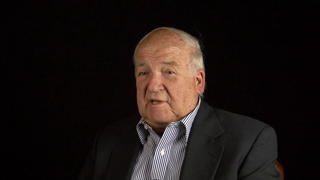4:18 | The Army was moving in to take over the base at Ky Ha, so Marine helicopter pilot John Jones had to pack up and move North, closer to the Demilitarized Zone at Phu Bai. The new base featured sand instead of mud. While there, he had a somber moment when he was called upon to transport dead Marines.
Keywords : John Jones helicopter pilot Vietnam Ky Ha I Corps Americal Division Chu Lai Phu Bai Da Nang Hue Marston Mat sand mud Dong Ha Khe Sanh Demilitarized Zone (DMZ) bodies rigor mortis wedding band

He was in ROTC and on the drill field when a B-52 flew over in all its glory and John Jones felt a patriotic urge. When he saw a recruiting poster for Marine Aviators, he new that was what he wanted to be. He had six siblings and felt that someone had to pay the price of freedom for all those kids.
After beginning flight training at Pensacola, Marine helicopter pilot John Jones moved to New River, a facility next to Camp Lejeune. He transitioned to the twin rotor H-46 helicopter, a military version of the Sea Knight passenger craft used by Pan Am. He knew he would be going to Vietnam and he didn't care.
Next to Chu Lai air base, the Marines had a helicopter base at Ky Ha. John Jones flew a twin rotor H-46 on transport missions from there and he describes arriving in country, the village nearby, and the only time the base was attacked. He was there a couple of months before he realized that people were shooting at his aircraft.
Helicopter transport pilot John Jones recalls the mission into Laos where he inserted a Special Operations group and then had to immediately extract them. When he took off, the overloaded aircraft crashed and he spent a tense night in the bush awaiting his own extraction.
Marine helicopter pilot John Jones recalls a fateful day when he switched aircraft with his friend, Bruce Eaton. Not long after the switch, it suffered a mechanical failure and crashed, killing all aboard. He had to pack up his friend's belongings to send home and he remembers a poignant moment when he saw a drawing that hung over the man's bunk.
Marine helicopter pilot John Jones suffered some superficial wounds when his aircraft was downed on a mission. While he was getting checked out for flight status, they wanted him to sign a list to get a Purple Heart. He refused.
John Jones describes his helicopter base at Phu Bai, which had new but very basic hooches for the men. On the other side of the runway was a very spartan international terminal used by the national airline. The only fire the base received was during the Tet Offensive when they were targeted by artillery.
Marine helicopter pilot John Jones will never forget the insertion mission when his gunner didn't fire his weapon despite receiving ground fire. He said there were kids on the porch of the hut. The source of the fire was clear. It was coming from the same hut.
John Jones recalls the time when his helicopter was rerouted to pick up a Viet Cong fighter waving a white flag. When he returned home, he knew he'd had enough of the service and he never flew again.